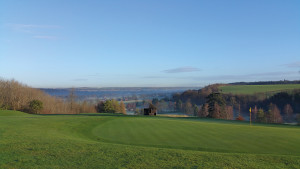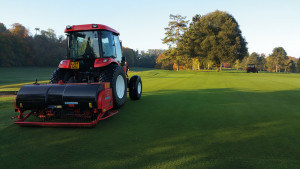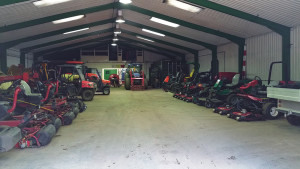Temple Golf Club - Honey to the BB&O

The chalk downland course was designed by 1887 and 1889 Open Champion Willie Park Junior and, to this day, the spirit of his 'inland links' course is maintained. The stunning views provide a picturesque backdrop for this challenging 18 hole course. Golf Course Manager, Ben Kebby, has been at the club for the past eighteen months, but he had a rather interesting journey to get there.
Ben describes himself as being quite artistic and aspired to be an architect. After completing college, he quickly learnt that CAD had taken over the world, and freehand drawing was a thing of the past, so he was at a loss as to what career path to take.
Ben commented: "At that time, I was playing golf at a fair level so I attended Merrist Wood College and undertook a HND in Golf Management. It was this that led me to a summer placement as a greenkeeper, at Sandford Springs Golf Club, which was the catalyst for my career in greenkeeping."

The soil profile of the course is a sandy loam, on a chalk downland and is split up as follows:
Greens 1ha
Approaches 0.5ha
Tees 1ha
Fairways 9ha
Meadow Rough 40ha
The greens are all originally of natural push up variety, but 100 years of topdressing and cultural practices have created a 20-25cm rich sandy loam profile. The tees have been raised significantly across the site and, again, have a rich profile; however, approaches have a very minimal soil depth above the chalk layer, which is very similar to the fairways.
The chalk downland boasts superb drainage, however the greens are holding a substantial thatch layer, which requires specific attention and a three to five year maintenance programme is now in place designed to reduce it. The techniques being adopted are; spring and autumn hollow core aeration followed by heavy topdressing, six weekly solid tining at varying depths, followed by topdressing and fortnightly Verticutting/brushing with a light topdressing. The fertility programme is also engineered in a way to be sympathetic to thatch minimisation. Currently, tees and approaches are on a basic solid tining aeration programme, but coupled with a specific fertility programme.

Ben describes the irrigation coverage on Tees and Fairways as either poor or non-existent, so the course can suffer from drought. "The fairways do not have an irrigation system, therefore have developed a high predominance of fescue, so drought does not cause plant loss or thinning of the sward and actually, in my opinion, creates a beautiful golden scene. Tees are the greatest problem at present as the irrigation is poor and grass sward doubly so, which means that attention and focus must be kept on these areas during high drought stress times. MJ Abbott are on hand as an extreme call out back up, they also prime and decommission the system each year."
There are a number of tees across the site which are too small in area to cope with the demand in play and coupled with high shade and extremely poor air flow, create poor performing surfaces, so there is an ongoing programme to increase air movement and light infiltration.
Ben commented: "The changing weather patterns have not directly impacted on my regime, however, I have started to notice, over the last few years, that October is fast becoming the month where the golf course and, especially the greens, are playing their best. This is from extended drought after the August rains, coupled with low night time temperatures, creating a firm, fast surface. All of this highlights the importance to take soil samples throughout the season, to check on continued progress and also to help guide the following aeration schedule. I will be looking to add leaf analysis in the future to better understand the plant itself, which will greatly help the control of diseases."
End of season renovations usually consist of vertidraining greens, approaches, tees and fairways, followed by topdressing all areas, with the exception of the fairways. The vertidrain aeration will be repeated monthly on fairways up until Christmas.

Assistant Greenkeeper (2 years service); Billy MacArthur, Apprentice Greenkeeeper (2 years service) and Jake Morries, Assistant Greenkeeper (started March 2016).
"I pride myself on my staff's professional development," said Ben. "I run an apprenticeship programme, introducing young staff members to the team and introducing them into the industry. They are offered a training scheme, coupled with studying towards NVQ Level 2, at Merrist Wood College. After this, I train all staff to NVQ Level 3 and offer additional Continual Professional Development (CPD) days for external lectures, workshops and/or competition work experience. Above NVQ Level 3, I offer tailor-made help for individuals pursuing further education. The apprenticeship programme we run is working great and I like to think that the apprentices I train now will be the Course Managers of the future."
Ben himself has the following qualifications: HND in Golf Management, HNC in Sports Turf Science, BSc in Sports Turf Science and has attended numerous BTME seminars and workshops.
"I am a strong advocate for attending all manner of industry events and, sitting on the BIGGA Berkshire, Buckinghamshire and Oxon (BB&O) Section committee as Education Officer, I actively encourage my staff to attend any and all events necessary to aid professional development," Ben continued.
Back on the course, Temple boasts a practice green, putting green and driving range, however, the practice green and driving range are situated away from the clubhouse, and the driving range is limited to 200 yards. There are plans in place to improve the driving range, namely the driving range tee.
Future plans include a five year bunker renovation programme, starting this year, with a view to entirely redesign and reconstruct all bunkers across the site. Integral to this renovation programme is a change of sand to create improved playing conditions and visual impact. Running alongside this is a five year tee enlargement programme, which started earlier this year, and finally there is also an ongoing woodland management programme.

"Here at the club, the local flora and fauna is extremely important, if not as important as the golf course itself. That is not just through interest in biodiversity, but the fact that we have one of the largest expanses of meadow rough in BB&O and the orchid populations have to be seen to be believed. Temple has had various surveys completed over the years on all manner of flora and fauna including, but not limited to, moths, butterflies and orchids."
Ben adheres to the Habitat and Woodland Management policy and works closely with Natural England, local bee keepers, schools, owl conservationists, bird conservationists and BB&O Wildlife Trust to ensure the on-site ecology manager is always up to speed and forward thinking.
Testament to this is the ongoing bird box conservation and owl box conservation, plus the possible introduction of four bee hives and plans for a further twenty in the near future, with a view to creating their own site specific 'Temple' honey.
Pest and weed control is both chemical and biological on the course. Weed control consists of a blanket herbicide twice per year through tees, fairways, approaches and green surrounds, and then spot treat, where necessary. In addition, the tees and approaches every 6 weeks corresponding aeration and topdressing, which aggravates broad-leaf weeds.

Ben continued: "We have a range of diseases that are present, Fusarium, Dollar Spot and Anthracnose, can all be seen on greens, tees and approaches at certain times throughout the year, whilst Red Thread is solely found on the fairways. Disease, as a rule, is controlled chemically. I apply three full rate blanket fungicides on the greens each year as a preventative and then I have an ongoing IPM programme, which includes spot treating where necessary throughout the season. Tees and approaches are outside my budget for control."
"The only mammal that we have a problem with is moles, and this is a very minimal problem. This is because the team are very hot on spotting mole hills and then immediately setting traps so as not to let the problem get out of hand and, as a result, the damage is little or non-existent. Chafer grubs have been a problem in the past, as have leatherjackets, and these were historically controlled chemically but, now that Chlorpyrifos has been withdrawn, it may be a difficult time for us ahead. It can be argued that worms are our biggest problem. They are prolific throughout the golf course, so I apply a wall to wall worm control, once per season coming into winter, and then spot treat further where necessary. Without this control, the golf course soon becomes extremely messy under foot, causing prolonged damage into spring, whilst also increasing weed populations."
The extensive treatments are costly and Ben has strict budgets he has to adhere to for treatments and when planning renovation works and winter projects, which dictate what and how much is achievable. "I request a specific, detailed, yearly, fully inclusive budget and then, on acceptance, the agreed budget is mine to delegate where necessary. Capital expenditure is slightly different; this is discussed through the Secretary and committee under my guidance."
Ben's current wish list consists of one further staff member, a Toro ProCore, two further utility vehicles, a sprayer and an excavator... in that order!
Purchasing machinery and equipment is done using a five to seven year rolling replacement programme, depending on specific machines. Smaller items, under £3,000, are usually purchased outright and Ben believes it's neither efficient nor wise to stay loyal to one brand.

"A number of different machines are hired throughout the year depending on tasks. For instance, an excavator is brought in during the winter months, a drop spreader and tractor for aeration maintenance, along with a turf cutter and fairway scarifying unit on occasions."
Deputy Course Manager, Mike Fyrth, takes on the role of mechanic for servicing and general maintenance and repairs. Monday and Friday afternoons where possible, are allocated for machinery servicing and repairs, whilst grinding and larger repairs are outsourced.
Ben is confident that the greenkeeping industry has never been in a better position. "The professionalism throughout the industry has vastly improved since I became a greenkeeper. I feel this is due to specific educational pathways for apprentices and greenkeepers, which now lead up to a Bachelors' degree and, more recently, a Masters' Degree. There is more help, encouragement and support now than there has ever been, due in part to the social media movement, but also the ever improving governing body. The golf industry as a whole is in slightly less of a positive position. The economic downturn has hit the sporting sector hard, but I feel, in the last two years, there has been a steady increase and golf clubs are slowly growing once more."
"Personally, I do not feel undervalued; in fact, I feel quite the opposite. Temple Golf Club has a fantastic membership base and an even better management structure; one which promotes the importance and value of each and every staff member. However, this has not come naturally. I have worked hard to build the value of the maintenance team through communication in the form of blogs, emails, notices and general day to day face to face communication. I also encourage my team to stop and say hello to members and answer any questions they may have. I am fully open with my management practices and describe in detail all cultural, fertility and chemical practices to allow the team to confidently answer questions."

"The blog is updated fortnightly through the summer and weekly through the winter, which forms a direct link between me, my team and the club members. I will be seen in and around the clubhouse on a daily basis and I make sure I interact in person with members as they play the course. I am considering a twitter feed for next season for instant interaction between myself and the members almost on a daily basis," concluded Ben.
What's in the shed
Ransomes Jacobsen Eclipse 322 greens mower
4 x Ransomes Jacobsen Eclipse pedestrian mowers
3 x Toro 3250 Triplex mowers
John Deere 7700 fairway mower
Ransomes Jacobsen LF570 fairway mower
Toro 4700 rough mower
Toro Sidewinder semi-rough mower
Ransomes 728 D front deck
2 x HDK electric utility vehicles
Kioti Mechron utility vehicle
2 x Cushman utility vehicles
Kioti RX6010 tractor
New Holland TN75D tractor
Amazon scarifier
Turfco topdresser
Hardi Boss sprayer
Smithco Tournament roller
Wiedenmann Terra Spike XF
4 x STIHL blowers
2 x STIHL strimmers
STIHL pole saw
STIHL hedge trimmer
Huxley:
Triplex brush
3 point linkage brush
Fairway brush
Sports Metal Triplex brush
Thatch Away units:
Verticut cassettes
Sorrel Roll cassettes
Poa Buster cassettes
Brush cassettes
